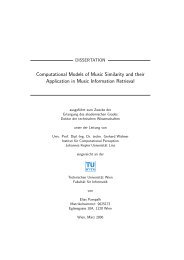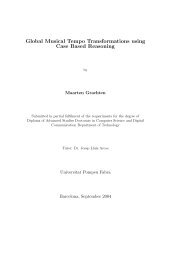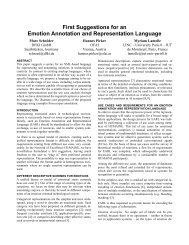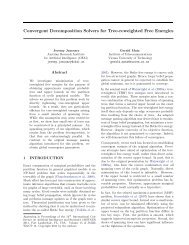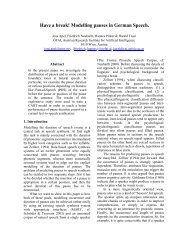A HYBRID MODEL OF REASONING BY ANALOGY
A HYBRID MODEL OF REASONING BY ANALOGY
A HYBRID MODEL OF REASONING BY ANALOGY
Create successful ePaper yourself
Turn your PDF publications into a flip-book with our unique Google optimized e-Paper software.
similar concepts (because they mutually activate each other through the links in LTM), and<br />
therefore the semantic constraint prevails over the structural one and in this way the chances of a<br />
successful mapping are lessened.<br />
5.3. The Transfer Process<br />
The purpose of the transfer process is to extend the mapping between two descriptions by<br />
constructing new slots in the target description that correspond to unmapped slots in the source and<br />
in this way to transfer new knowledge to the current situation.<br />
Two kinds of slot transfer in AMBR will be considered in this subsection: transfer of an aspect slot<br />
and transfer of a relation slot (action slots will not be considered for the time being). When a<br />
relation slot is transferred, it is actually the corresponding proposition that is transferred, e.g. P(x)<br />
or P(x1, .., xn), where P is a relation described by another description frame and x, x1, .., xn are<br />
aspect slots with c-coref links to the descriptions of the fillers. For simplicity, only propositions of<br />
type P(x) will be considered further; everything said about them will concern relations of arbitrary<br />
arity as well. The following cases can be considered.<br />
1) If, during mapping, both the aspect slot x and the relation P are mapped on x' and P'<br />
respectively, then the slot corresponding to the proposition P(x) is easily transferred to a new slot<br />
with a c-coref link to a description of the proposition P'(x'), i.e.<br />
x ---> x'<br />
P ---> P'<br />
----------------<br />
P(x) ---> P'(x')<br />
If, however, during mapping no correspondence is found for x or for P, then the reasoner is faced<br />
with more difficult problems as discussed in 2) and 3).<br />
2) If the object correspondence is known but the relation correspondence is unknown, i.e.<br />
x ---> x'<br />
P ---> ?<br />
-----------<br />
P(x) ---> ?<br />
then either the same relation can be transferred: P(x) ---> P(x'), or a reinstantiation P' of some<br />
superclass Q of P can be produced: P(x) ---> P'(x'), or the generalization Q can be used: P(x) ---><br />
Q(x'). The particular decision would depend on the associative relevance of P, Q, and P', and on<br />
the decisions of the evaluation process. The above is illustrated by the following examples:<br />
water ---> coffee<br />
container ---> cup<br />
in ---> ?<br />
-----------------------------------------<br />
in(water, container) ---> in(coffee, cup)




